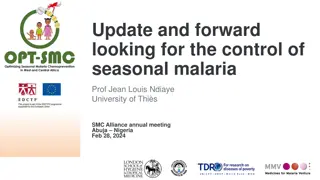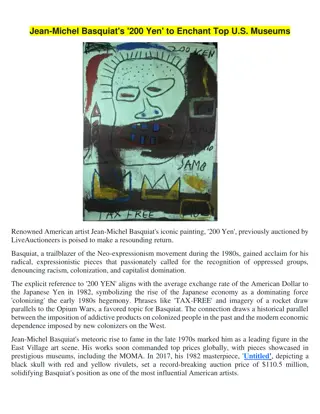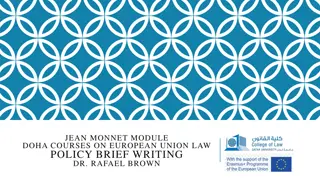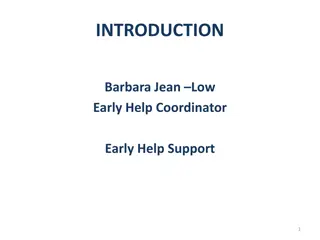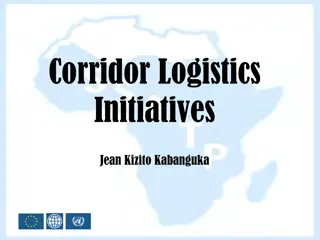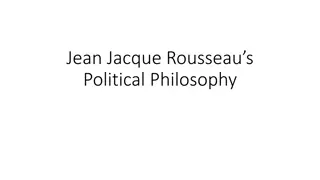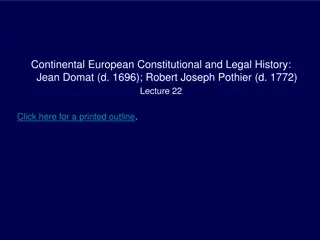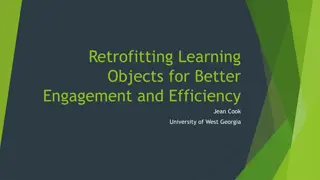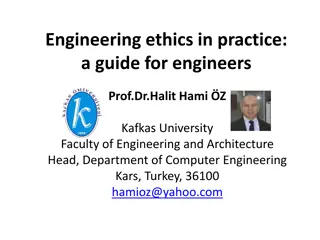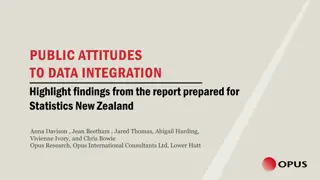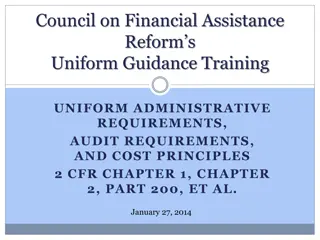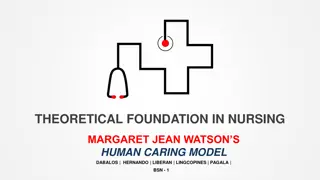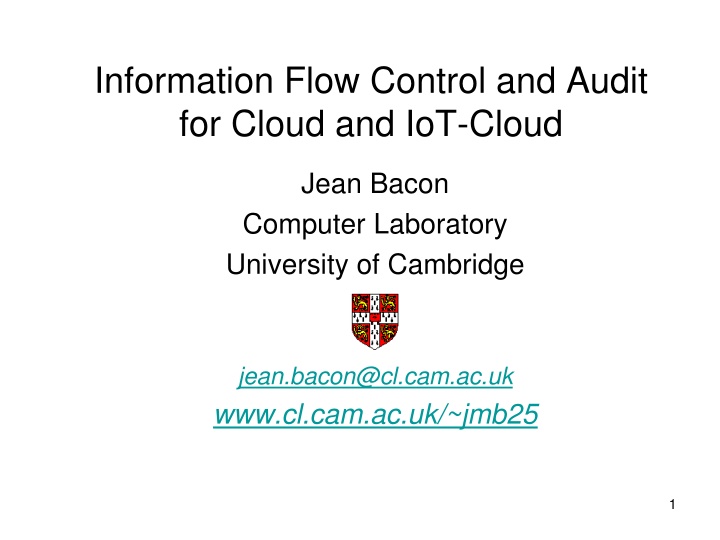
Enforcing Information Flow Control for Cloud and IoT Security
Explore the significance of Information Flow Control (IFC) in ensuring security in cloud and IoT environments. Learn about the challenges, implementations, and benefits of IFC for protecting sensitive data and enforcing regulations. Discover how IFC enhances security measures beyond traditional methods to address evolving security concerns in cloud computing.
Download Presentation

Please find below an Image/Link to download the presentation.
The content on the website is provided AS IS for your information and personal use only. It may not be sold, licensed, or shared on other websites without obtaining consent from the author. If you encounter any issues during the download, it is possible that the publisher has removed the file from their server.
You are allowed to download the files provided on this website for personal or commercial use, subject to the condition that they are used lawfully. All files are the property of their respective owners.
The content on the website is provided AS IS for your information and personal use only. It may not be sold, licensed, or shared on other websites without obtaining consent from the author.
E N D
Presentation Transcript
Information Flow Control and Audit for Cloud and IoT-Cloud Jean Bacon Computer Laboratory University of Cambridge jean.bacon@cl.cam.ac.uk www.cl.cam.ac.uk/~jmb25 1
Projects CloudSafetyNet (EPSRC), with Imperial College, Otago NZ, PHE End-to-End Application Security in the Cloud investigate (Decentralised) Information Flow Control (IFC) as a security technology for cloud computing Jatinder Singh (PDRA), Thomas Pasquier (PGRA) Microsoft Cloud Computing Research Centre, with QMUL investigating technology to enforce laws/regulations and to demonstrate compliance and accountability 2
Structure of the talk Need for protection, sharing and audit in cloud and cloud-IoT Why cloud services are good for IoT Traditional security is necessary but not sufficient ------------------- (Decentralised) Information Flow Control (IFC) introduction and examples IFC CamFlow implementation (very brief) What IFC can contribute potential of IFC 3
Motivation Security concerns hinder cloud adoption Therefore, cloud design focus has always been on strong isolation to keep tenants separate via VMs at IaaS level (e.g. Xen) via containers above a common OS for PaaS and SaaS levels also, IaaS level may provide an OS Even with strong isolation technology, private clouds are still used for sensitive data e.g. PHE cancer registry 4
Isolation via Containers (e.g. Docker) App A container App B container App A Ann Resources App A Bob App B Bob Resources App B Carl Cloud OS Access Control is done separately by App A and App B Ann can t interact with Carl Bob (App A) can t share data with Bob (App B) Sharing requires mutual trust e.g. if Bob s App A data is shared with App B, App A must trust App B not to leak it to Carl. No further control over data once access is granted 5
Data Sharing Requirements Cloud Sharing/interaction between related applications e.g. local government apps share data on citizens such as: council tax, parking fines, social services, electoral roll e.g. marketplace of open services compose dynamically to create higher-level services. such as: GCloud, Open Cloud Exchange (OCX) Public - Private cloud interaction e.g. health records on private cloud patients web portal on public cloud patients personal health and lifestyle monitoring data in home system and/or public or personal edge-cloud Need protection AND controlled sharing . .. even more for IoT-Cloud 6
IoT-Cloud illustration ISO: an infrastructure of interconnected objects, people, systems and information resources together with intelligent services to allow them to process information of the physical and virtual world and to react. 7
IoT Vision ISO: an infrastructure of interconnected objects, people, systems and information resources together with intelligent services to allow them to process information of the physical and virtual world and to react. Characteristics of IoT Personal, sensitive data (ubiquitous surveillance) Dynamic composition of `things to create new applications - possibly unforeseen by things developers Implication `things cannot contain embedded policy on their usage can t stop the world to recompile, reconfigure and restart policy needs to be managed separately policy controls `things configurations and interactions dynamically 8
IoT-Cloud Benefits Cloud services have a part to play in IoT Cloud services can operate across devices, systems, services, . Natural place for data aggregation and analysis Natural place for management, coordination and control (policy) Natural place for sharing data between `things Benefits of using Cloud components in IoT Always on Resources scale to meet demand Support offloading for computation and storage e.g. from resource-constrained `things 9
Security for Cloud and Cloud-IoT Isolation technology cloud isolation technology can be used as needed for protection without sharing as well as data protection, data sharing will also be needed OTS/standard security technologies point-to-point encryption for communications application-level encryption of data - needs (complex) key management for processing and sharing PKI to identify entities (`things , `things owners, etc.) Access Control for cloud and cloud-IoT? 10
Traditional Access Controls - 1 Authentication you are who you say you are use passwords, public/private key-pairs, biometrics Authorisation you are entitled to carry out some action use ACLs, Role Certificates, Capabilities These are: Application specific policy consistency not ensured across applications cloud-provided data stores are shared by apps Principal/Role - specific Applied only at specific Policy Enforcement Points (PEPs) 11
Traditional Access Controls - 2 After access is granted: No subsequent control over data-use by authorised party No guarantee of consistent policy when apps are combined/configured dynamically IoT similarly no control after data leaves personal domain e.g. I may consent to usage A of my data but it may be used subsequently for B without my knowledge 12
Legal/Regulatory Sanctions? Current cloud contracts take it or leave it if a service is free, you re not the customer, you re the product provider accepts no responsibility for data loss or data leakage you agree to data analytics and targeted advertising Ref Cloud Computing Law OUP 2013, ed. C. Millard 13
Audit Need for Audit for both Cloud and IoT How has data been used as it flows system-wide? Compliance with contract if negotiated contracts were possible . Compliance with law and regulation, e.g. EU C7-0025/12 personal data on EU citizens should not leave the EU Manual compliance processes are very expensive (certification) 14
CloudSafetyNet Project Clouds need continuous, system-wide, data flow control to provide protection AND (cross-application) sharing with audit for accountability to demonstrate compliance/provenance - investigate IFC for this purpose Cloud-provided software is more trustworthy and trusted than apps running as cloud tenants with end users - investigate IFC as a cloud-OS mechanism for PaaS and SaaS clouds. 15
Structure of the talk Need for protection, sharing and audit in cloud and IoT-cloud Why cloud services are good for IoT Traditional security is necessary but not sufficient ------------------------------ (Decentralised) Information Flow Control (IFC) introduction and examples IFC CamFlow implementation (very brief) What IFC can contribute potential of IFC 16
Information Flow Control (IFC) Continuous, system-wide, data flow control with audit Data is tagged tags stay with (stick to) data as metadata A tag represents a security concern e.g. e.g. source, type, sensitivity, state EU, hosp-dev, medical, personal, ann, encrypted, anonymised Tags are grouped into labels Secrecy label S and Integrity label I are sets of tags e.g. S = {medical, ann} I = {hosp-dev, consent} All entities, whether active or passive, are labelled (data, processes, pipes, files, messages etc.) Definition: the state of S and I is the security context of the entity 17
IFC Flow Rule Data can flow from entity A to entity B (A B) where A has labels secrecy S(A), integrity I(A) and B has labels S(B), I(B) A B if and only if S(A) S(B) AND I(B) I(A) S: anything I send to must have at least my secrecy tags I: anything that sends to me must have at least my integrity tags 18
IFC Flow Rule (secrecy) Secrecy: for privacy/confidentiality for A B check whether B is entitled to receive this data e.g. original use: Bell-LaPadula system-wide security classification no read up, no write down . Using tags rather than a class hierarchy: secret data can flow to top-secret: S(A) = {secret}, S(B) = {confidential, secret, top-secret} S(A) S(B) top-secret can t flow to secret: S(B) = {secret, top-secret} S(C) = {secret} S(B) S(C) 19
IFC Flow Rule (integrity 1) Integrity: the data quality/format, the sender s authority to send, what the recipient will take responsibility for accepting data quality/format: data from across the network and user input are not trustworthy downloaded software may be from an untrusted source input code/scripts may be attacks data may be from a non-standard device (BYOD) and/or in a non-standard data format 20
IFC Flow Rule (integrity 2) Integrity: the sender s authority to send, what the recipient will take responsibility for accepting actuation commands can be dangerous, check who s sending to internet-enabled `things e.g. vehicles, drones, hospital temperature control, door lock control (entire path and data need validation more than point-to-point flow) personal data on EU citizens should not leave the EU A: S={medical}, I={EU} B: S={medical}, I={US} I(B) I(A) a statistics generator can/will only input data from consenting people StatsGen Process: S={medical}, I={consent} 21
Reminder (slide 5): Isolation via Containers App A container App B container App A Ann Resources App A Bob App B Bob Resources App B Carl Cloud OS From slide 5: Sharing requires mutual trust e.g. if Bob s App A data is shared with App B, App A must trust App B not to leak it to Carl. No further control over data once access is granted 22
Cloud Container Example redone with IFC (S) AppA Bob AppB Bob AppA Ann AppB Carl S={cambsA, bob, cambsB} S= {cambsB, bob, cambsA} S={cambsB, carl, cambsA, ann} S={cambsA, ann} Cloud OS with IFC enforcement Protection between App A and App B by secrecy tags cambsA and cambsB, and between end users of apps by secrecy tags ann, bob, carl Sharing only allowed when tags are propagated to App instances according to policy and negotiation Note: one-way or two-way flow can be set up. Two-way needs equal tags. One way: S={cambsA, ann} to S={cambsB, carl, cambsA, ann} not vice-versa. Carl can only send Ann s data to a process with S containing {cambsA, ann} (in fact, destination s S label must contain tags {cambsB, carl, cambsA, ann} ) 23
IFC: IoT-Cloud System Example Sensor manager, collects data for processing and storage Ann s Home Monitoring App S = {medical, ann} I = {hosp-dev, consent} Zeb s Home Monitoring App S = {medical, zeb} I = {byod, consent} I: check source I has hosp-dev, consent Illegal flow (prevented) destination S has no zeb source I has no hosp-dev S: check destination S has medical, ann X Ann s (Cloud-Based) Hospital Data Analysis App S = {medical, ann} I = {hosp-dev, consent} Aggregates and analyses data detects potential emergencies sends alerts to emergency services 24
IFC Creation Rule When an active entity creates another entity the child (created entity) inherits the labels of its parent (creator) e.g. process (by fork), file, pipe, creating a message to send So how can you create a child with fewer tags than you? Privileged processes can change their security context they have privilege-sets of tags that they can add-to/remove-from their S and I labels in our system CamFlow, label change must be explicit (implicit is dangerous could accidentally declassify and send out top secret data) 25
IFC: Creation of Labelled Entities application instances never change security context - unaware of IFC Ann s Home Monitoring App S = {medical, ann} I = {hosp-dev, consent} Ann s Hospital Data Analysis App S = {medical, ann} I = {hosp-dev, consent} Manager changes its security context before creating Ann s Apps creation S = {medical, ann} I = {hosp-dev, consent} Manager of Hospital Home Monitoring S = {medical, ann, ., zeb} I = {hosp-dev, byod, consent} A privileged Application Manager process 26
IFC Endorsement this process is instanced for each patient to manage sensor data Zeb s Home Monitoring App S = {medical, zeb} I = {byod, consent} privileged Input Sanitiser sets up its security context to read Zeb s non-standard data and convert it into standard form S = {medical, zeb} I = {byod, consent} Device Input Sanitiser S = {medical, zeb} I = {hosp-dev, consent} it changes its security context to output data in standard format to the Data Analyser Zeb s Hospital Data Analysis App S = {medical, zeb} I = {hosp-dev, consent} this process is instanced for each patient to read data in standard format for processing 27
IFC Declassification Ann s (cloud-based) Hospital Data Analysis App. S = {medical, ann} I = {hosp-dev, consent} (standardised) data from other patients bob zeb creates stats, anonymises data changes security context before output S = {medical, ann, ., zeb} I = {hosp-dev, consent} Hospital Home-Monitoring Statistics Generator S = {medical, stats} I = {anon} output can only go to appropriately labelled process Hospital Manager (human) S = {medical, stats} I = {anon} Hospital Manager cannot read and does not take responsibility for knowing individual patient data 28
Composing components etc. . Ann s Home Monitoring App Zeb s Home Monitoring App emergency actuations Input Sanitiser etc. . Ann s Data Analyser Zeb s Data Analyser data analyser detects emergency, sends alerts emergency doctor Hospital Home-Monitoring Statistics Generator Medical Research Statistics Generator new components can be configured into the system Hospital Manager Medical Researcher Medical Researcher 29
IFC Summary IFC enforces data flows according to policy provides protection and sharing as required Tags are metadata, transparent to entities Very simple policy expression Continuous enforcement on every data flow Audit all flows can be recorded at a level meaningful to applications (a.o.t. syslogs) 30
IFC Implementation Implemented? FlowR (Ruby+AoP), FlowK (syscall intercept) CamFlow - OS level: 2 open source LSMs www.camflow.org CamFlow IFC and CamFlow Audit. (LSMs became stackable during the project.) - middleware: still some work needed on SBUS integration ongoing work by Pasquier at Harvard uses MQTT Overhead? CamFlow neglibible in OS for cloud IoT still to be evaluated Does software have to be rewritten to run with IFC? Only (App) managers that need to change their security context. (WiP on automating this - see ACM SACMAT 2016) App instances can run without IFC awareness. 31
CamFlow OS-level Implementation secure security contexts (S,I) set up for end users App instances. context store translate between application-level tag names and kernel-level names (64 bit IDs) Application Process (S, I ) Library with CamFlow Name/Context Manager CamFlowtrusted process Library with CamFlow CamFlow Messaging trusted process Library with CamFlow send message OS kernel CamFlow LSMs message to remote process System calls are unchanged Linux Security Module (LSM) enforces IFC Rest of OS kernel is unchanged for maintainability Processes need not be aware of IFC unless they are privileged to change their security context (S,I) IFC calls via CamFlow library 32
Much work remains Our publications to date are at http://cl.cam.ac.uk/research/srg/opera/publications There are many interesting questions to work on! More: Thursday Session 5 13:45 Big Ideas paper: Policy-driven middleware for a legally compliant IoT Presented by Jat Singh Thank You ! 33
IFC A Brief History 1976: Denning security hierarchies data labelled principals also labelled according to their security clearance 1990s IFC in languages and libraries (decentralised IFC (DIFC)) e.g. Myers and Liskov SOSP 1997 2000s IFC at the OS level e.g. Flume, SOSP 2007 Distributed OS e.g. Dstar, Usenix 2008 2014 IFC implementations summarised in our IEEE TNSM paper 34
IFC: Two-Component (2D) Tags For large-scale data processing we propose 2D tags of the form <concern, specifier> e.g. Ann may have tags <medical, ann>, <personal, ann> etc. <medical,*> stands for all specifiers of concern medical data from other patients Ann s Hospital Data Analysis App S = {<medical, ann>} I = {<dev, hosp-dev>, <consent, Y>} Monitor changes its security context (declassifies the data) before output S = {<medical, *>} I = {<dev, hosp-dev>, <consent,Y>} Hospital Home-Monitoring Statistics Generator S = {<medical, stats>} I = {<state, anon>, <consent, Y>} can only output to appropriately labelled process Hospital Policy Manager S = {<medical, stats>} I = {<state, anon>, <consent, Y>} 35


